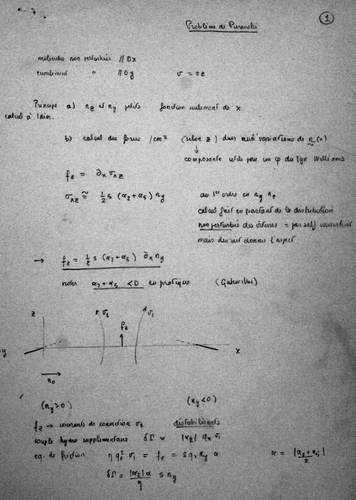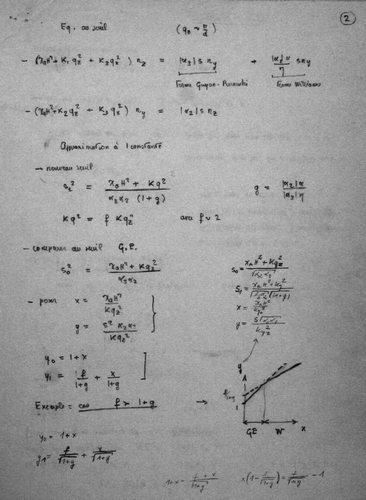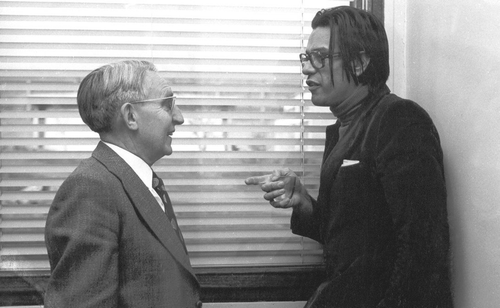Personal recollections by Pawel Pieranski and Etienne Guyon
The most delicate state of matter
It is a summer night in June 2007. After a 25,000 year journey through space, photons sent by 400,000 stars from the globular cluster M13 excite, one by one, electrons in the CCD camera located in the focal plane of an 8 inch Newtonian telescope. After 10 minutes, the photon harvest is transformed into an image that appears on the Liquid Crystal display of a laptop computer. The bewitching notes of the Moonlight Sonata played by somebody in the neighbourhood (surely not by Pat, this being in France) titillate auditive cilia which send electrical impulses through myelin coated nerve fibres to the brain. The brain is at work: it has to compose an obituary for Pierre‐Gilles de Gennes, who died on 18th May, 2007, at the age of 74.
The first image that comes to mind is the beautiful photograph from a card announcing his death: it shows a young, tall man, with a mop of tousled long hair, looking at something far away. Maybe at the sunset; shadows on this smiling face suggest that the Sun is low in the sky. All of those who had the good fortune to listen to lectures by de Gennes in Orsay or in the Collège de France, to be directed by him, to collaborate with him, or simply to meet him and have a conversation on any subject, know just how charming this man was. Among those who succumbed immediately to this charm, the first two were probably Rudolf Peierls and Anatol Abragam. To explain this, we have to recall the beginning of the scientific trajectory of de Gennes. After graduation from the Ecole Normale Supérieure (1955), he worked for his thesis on magnetism, from 1955 to 1961, in the Centre d'Etudes Nucléaires in Saclay and participated as a student at the Summer School on Theoretical Physics in Les Houches in 1953.
It is a summer night in July 1953. Pierre‐Gilles de Gennes and Philippe Nozières are sleeping in the hayloft of a cottage in Les Houches. We know this from the autobiography of Rudolf Peierls The Bird of Passage. At this pioneering time of the famous Summer School, only professors had the privilege of being lodged in country cottages, while students had to sleep either in sheep‐pens or in tents. It happened that the cottage allocated to Peierls and his wife had a hayloft. Taking pity on the poor students frozen by cold summer nights in the mountain, the Peierls family lodged two of them in the hayloft. In his story, the charmed Peierls names the happy two and adds that one of them used to play the guitar. De Gennes, who always emphasized the role played by the Summer Schools in Les Houches in developing scientific vocations, confessed many years later that he was the guitarist. Philippe Nozières gave some other details about this memorable year of 1953:
“At the end of the school, students had to pass an examination in a style unusual for French scholars: Peierls proposed half a dozen subjects, we had to choose one and then write an essay in 24 hours. We were 21 years old and our enthusiasm was much larger than our knowledge of physics. I chose a subject that I was able, roughly, to grasp and worked on it all night. De Gennes, on his own, took another subject with the title, incomprehensible for me (in 1953) “Adiabaticity in thermodynamics and in quantum mechanics”. (…) Recently, when I asked him about this examination, he just laughed and said “what in the hell could I say about that?” Anyhow, Peierls was impressed. Regardless of the details of this examination, the point is that de Gennes was attracted by the challenge and felt the importance of the problem: what a nice proof of his unfailing intuition and of the taste of the challenge.”
To recount the testimony of Anatol Abragam, we have to change the scenery and to recall another summer day: 28th June 2002. In the morning, the sky is clear; the dome of the Pantheon is visible from the road between Orsay and Paris. Upon the formidable impetus exerted by the first PhD student of de Gennes (EG), a Jubilee in honour of the 70th birthday of de Gennes is about to take place. The program is composed of a series of talks illustrating the scientific trajectory of de Gennes: the CEA in Saclay, the Laboratoire de Physique des Solides in Orsay, the Ecole de Chimie et Physique de la ville de Paris and the Collège de France. The splendid, monumental Amphitheatre of Marguerite de Navarre in the Collège de France is full of people waiting for de Gennes. He arrives, smiling, walking fast, as always, and saying “Salut, salut, comment ça va?”
The first speaker is Anatol Abragam, the mentor of de Gennes from CEA. In the abstract of his talk, he wrote:
“In 1953, I came back from USA.[…] During the Aigrain seminar in ENS, a report on the Overhauser effect is given by a young man, with long hair reaching his eyes. And this young man is providing explanations so clear and so convincing that I cannot resist telling Horowitz, sitting close to me: this lanky boy will go very far[…]. Another recollection, about twenty years later. I am attending the inaugural conference of de Gennes in the Collège de France. Raymond Aron (a philosopher) is sitting by my side. The talk of de Gennes triggers an irrepressible enthusiasm of Aron who shouts : Ce garçon pète d'intelligence ! (This kid sparkles with intelligence!).”
In this necessarily short obituary, it is impossible to even outline the scientific trajectory of de Gennes. We could say, perhaps, that it was exceptional, like the trajectory of a space probe, which launched from Earth, passes from planet to planet using the catapult effect and goes faster and faster.
In Saclay, de Gennes worked on magnetism. According to one of the speakers at the Jubilee, de Gennes tested first his skill as an experimentalist but when he “gave up and decided to use as tools only the pen and eraser” a kind of relief was felt by his colleagues. For the rest of his life, de Gennes was a theorist inspiring countless experiments although – from time to time, and especially during popularisation conferences – he loved to illustrate his explanations by experiments performed with his own hands. Most of the time, these demonstrations were appreciated by the audience but it happened, at least once, that his experiment triggered a disappointment. Invited by Bernard Pivot to a TV literary program “Bouillon de culture”, de Gennes dazzled the journalist and other participants by his knowledge of literature and poetry. At the end, he decided to show an experiment with shaken sand. “Look, how perfect is the pile that forms spontaneously when the sand is shaken! And, you must know that we do not know why it is so!” The reaction of the journalist expressed his disappointment: “You do not understand that?”
From Saclay, de Gennes moved in 1959 to the Laboratoire de Physique des Solides in Orsay. In his memories “Graine de mandarin”, Jacques Friedel, the founder (with André Guinier and Raimond Castaing) of this laboratory, gives a detailed report on the circumstances in which de Gennes joined the laboratory after a stay with Kittel in Berkeley. According to Friedel, “de Gennes acted as a powerful stimulant of research and attracted physicists from CEA”. During this period, de Gennes became a lecturer in the DEA (a predoctoral programme) “Physique des Solides”. One should emphasize that he was a marvellous teacher, demanding constant efforts from his students and simultaneously offering them his generous help.
In Orsay, de Gennes worked on the theory of superconductivity and to test his ideas, he created his first group of experimental research. Using the metaphor of the space probe, we could say that from heights accessible only to him, he examined the whole planet and described it in his book Superconductivity of metals and alloys.
After that, with an increased velocity he started the journey to the next planet named Liquid Crystals. There are several reasons why this direction was taken. For instance, one could say that in Orsay this subject was a matter of heritage: Georges Friedel, one of the precursors of Liquid Crystals, was the grandfather of Jacques.
These were the “years of fat cows”. Several competing but nevertheless mutually inspiring experimental teams, composed mostly of very young people, directed by hardly older coaches (Georges Durand, Maurice Kleman, Jean Charvolin,…), started to work simultaneously on thermotropic and lyotropic systems. A team of chemists (initiated by Leszek Strzelecki and Lionel Liebert) was the essential piece of this clockwork. All the PhD students and their supervisors were animated by the desire to find something new that de Gennes would like. Many experiments were inspired by the theoretical predictions of de Gennes. Other experiments inspired in turn by the theoretical work of de Gennes. He would visit us frequently and would ask: “Alors, qu'as tu trouvé de nouveau?” He would listen to our explanations and would say “Oui, oui, d'accord”. After more or less clear reports, he would explain to us the physical meaning of our experiments and calculations, while writing simultaneously formula on the blackboard. We would listen to him with all our attention and after his departure the prohibition “DO NOT WIPE!!!” would protect de Gennes' formula for a week or two. It happened too that the next day after the visit, de Gennes would come back to the laboratory with a few pages of calculations. As an example, we show in figure photographs of two such pages. Here, de Gennes is explaining to us in a few lines the origin of roll instabilities in a nematic layer submitted to shear flow which he had just understood! Other examples of such three‐line calculations embracing new classes of phenomena (Rayleigh‐Benard convection, electrohydrodynamic instabilities, etc.) sleep probably in the draws of many other colleagues. In summary, the working scheme in Orsay was the best one: a strong coupling between the theory and experiment, between physics and chemistry.
Figure 2 Two pages of calculation brought by de Gennes the day after his visit to the laboratory. He offered to us the explanation of roll instabilities in a nematic layer subject to shear flow.


Our findings were presented during international meetings. One can say that all the young people from Orsay benefited greatly from the aura of de Gennes. The role played by de Gennes at the international level in the field of liquid crystals is certainly well‐known to many readers of this Journal. Some of them visited Orsay, worked here for a while or were visited by de Gennes in their own laboratories. Some others remember very well the magic of the de Gennes' style when he spoke at conferences on liquid crystals.
Let us just recall the International Conference on Liquid Crystals in Stockholm in 1974 because the scenery of this meeting is once again a summer day followed by the longest night of the year beloved by Nordic peoples. Did de Gennes suspect that he would come back to Stockholm about two decades later to receive from the hands of the Swedish King the Nobel Prize? We will see later what the answer to this question was.
It is impossible here to make an exhaustive list of de Gennes' contributions to the field of liquid crystals. However, if we had to give just two examples, the first would be his classic book The Physics of Liquid Crystals. It was an outcome of lectures given in Orsay and of the very first series of lectures that he gave as a professor in the Collège de France. Several people from Orsay had the privilege of reading the first version of the book, in the form of isolated chapters. From this period of the work on the book, a very precise recollection comes to mind. Once again it is summer. We are, as de Gennes and as other members of the Orsay Liquid Crystal Group (Elisabeth Dubois‐Violette, Maurice Kleman,…) in Les Houches as students during the Summer School on the physics of fluids (1973). Since the Peierls era, quite comfortable dormitories for students have been constructed. It is fortunate because the weather is so cold and for two weeks it has been raining cats and dogs. The best thing we can do in the afternoon free time is to work on our lecture notes. De Gennes is correcting proofs of this book. During this School, and more generally during all his life, de Gennes was always at work in one way and another : proof reading as well as anticipating the classes he would give on fluid mechanics the next year in the Collège de France.
Once published, this book immediately became a bestseller. We are tempted to say that, before this book, the field of liquid crystals was like a sky with plenty of stars, planets, galaxies, nebulas and so many other strange objects that exist in our Universe, and that de Gennes, who was an incredibly gifted sketcher, drew lines connecting stars into constellations and by this action made the sky more comprehensible.
As a second example of de Gennes' achievements in the field of liquid crystals, we could quote his analogy between between vortices in superconductors and dislocations in smectic A phases. In the presentation speech during the Nobel Prize ceremony we can read: “De Gennes has discovered relations between different, seemingly quite unrelated, fields of physics – connections which nobody has seen before.” It took more than twenty years to find the TGB phases predicted by de Gennes' theory.
From liquid crystals, the trajectory of de Gennes led him to polymers. He surveyed this new planet, gave a new series of lectures in the Collège de France and, when his book “Scaling Concepts in Polymer Physics” was published, we knew that it was the signal of his departure on new adventures. When today, inspired by twinkling stars, we think about the destiny of this exceptional man, the drawing on the first page of “Scaling Concepts in Polymer Physics” strikes our imagination: it represents a series of very simple graphs that look like constellations. Does somebody know what their meaning is?
After polymers, de Gennes became interested in wetting, adhesion and granular materials. And then suddenly, in 1991, radios, televisions and newspapers announced the news: the Nobel Prize had been awarded to de Gennes. Madeleine Veyssié, with whom, since 1972, de Gennes created the new laboratory in the Collège de France, gave a lively description of this event in her lecture during the 70th anniversary Jubilee :
“[…]a tremendous joy (was) triggered by the Nobel Prize : there was an uproar in the laboratory, many preposterous questions were asked by journalists, a family fiesta (took place) in the laboratory, (there was) a formal ceremony at the Sorbonne and some reflected glory upon each of us; in spite of our constant protestations, nobody wanted to believe that we had no merit… and moreover that de Gennes was a theorist”.
In fact, exactly the same scenes of a collective joy took place in all laboratories where de Gennes had worked, all over the world.
Many of us watched on television the ceremony in Stockholm. The tall silhouette of de Gennes was perfect for the traditional tailcoat. He was obviously proud and happy to be there but still was lucid enough to say during the banquet speech:
“This is the first, and probably the last time in my life where I have dinner with queens and princesses. I am worried. I suspect that with the chimes of midnight I will be turned into a pumpkin. I have come often to this beautiful city of Stockholm. As a matter of fact, once in 1974 I attended a banquet in this very same room. This was during a conference on liquid crystals. And I was asked to give a three minute talk. But in those days I still had some common sense, I said: No, this is too hard. My friend Tony Arrott took over and did very well. But now I finally understand why I have been given this fabulous prize, not because of some scientific achievement but because the Swedes are stubborn. They wanted me to give a three minute talk in this hall.”
Some were saying that de Gennes was “the Newton of our time” but he did not like this and used to say:
“The stature of Newton was much higher than that of contemporary researchers. As a very young man he invented the reflecting telescope, wrote his treatise “New Theory about Light and Colors”, and finally understood the gravitation and its role in the motion of planets.”
We can understand and share the admiration of de Gennes. Even today, Newtonian telescopes are the favoured instruments of amateur astronomers and planets move in agreement with the law of gravitation. But all this will not affect our admiration of de Gennes. As a researcher, he was incredibly fertile. The list of his publications that runs to several hundred papers on varied subjects is striking. His place among giants like Kelvin, Rayleigh or Landau seems assured.
In his last years, de Gennes worked at the Institut Curie on several problems dealing with the most fragile state of matter – life. At first, he was fascinated by the olfactive skills and memory of bacteria. Later, he started to work on the structure of the brain.
Today, de Gennes is no longer among us. After several accelerations, his trajectory has taken him, irreversibly, in the direction of the stars. We watch stars in the night, listening to the Moonlight Sonata and wonder about de Gennes and those with whom he is now…
“The vastness of the heavens stretches my imagination – stuck on this carousel my little eye can catch one‐million‐year‐old light. A vast pattern – of which I was a part – perhaps my stuff was belched from some forgotten star, as one is belching there . . . It does not do harm to the mystery to know a little about it. Far more marvellous is the truth than any artists of the past imagined!”
Richard Feynman

